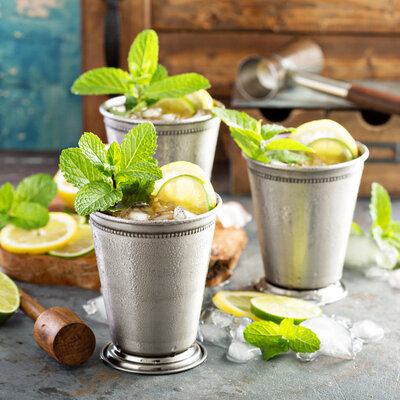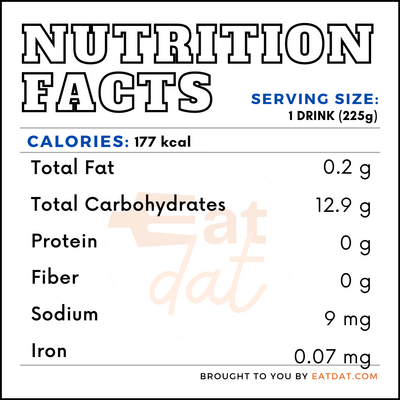
Mint Julep
What is a Mint Julep?
Mint Julep is a cocktail made with bourbon whiskey, sugar, water, crushed ice, and mint. It is of American origin and often associated with the southern part of the country. It has a yellowish color and a minty flavor with a hint of sweetness.
- This drink is closely associated with the Kentucky Derby, which takes place in May every year, where thousands of glasses are consumed.
- Thus, it is considered to be a summer cocktail.
The best whiskies for preparing this cocktail are:
- Buffalo Trace
- Knob Creek
- Michter’s
- Heaven Hill
- Four Roses
- Bulleit
- Woodford Reserve
Origin of mint julep
The Mint Julep is believed to have developed from the Arabic julab, a drink made with water and rose petals. When this beverage traveled to the Mediterranean region, mint replaced the rose petals. This concoction was even prescribed for stomach aches. Later on, the drink spread to North America in the 1700s. The first documented mention of this drink was in 1803. However, it only became the official drink of the Kentucky Derby in 1983.
Nutrition
Nutritional profile for Mint Julep (1 drink/225 g):

Because whiskey is distilled in copper stills, it contains copper, which helps in the creation of red blood cells, absorbs iron, boosts the immune system, and protects cells. It prevents the onset of anemia and osteoporosis. Also, whiskey contains antioxidants, which help in preventing heart diseases. The drink also controls urate levels by promoting excretion of urate through urine, which can prevent gout and other uric acid diseases.
Spearmint is rich in polyphenols such as rosmarinic acid, which has a positive effect on cognitive performance, sleep, and is a mood enhancer and relaxant. Additionally, it may reduce age-related memory impairment. Sugar can be good for the health of the brain, provided it is taken in balanced quantities. However, overconsumption of sugar can lead to an increase in the risk of heart diseases, diabetes, cancer, and other diseases. Also, it can lead to obesity, depression, and aging.
Like any other alcoholic drink, overconsumption can result in a change in the brain’s functioning patterns, liver cirrhosis, pancreatitis, heart problems, strokes, different types of cancers, as well as affect overall immunity.
Commercial production
To prepare a Mint Julep, the ingredients required are bourbon whiskey, sugar, and mint. First, the mint and sugar syrup are put in the glass and crushed to release the flavor of the mint. Then, crushed ice is added, and then water, and the bourbon is poured in last, and stirred. The usual garnish is a mint leaf. Mint Julep is ideally served in a rocks glass or a silver cup, although traditionally, pewter cups were used. The straw should be short enough to still smell the cocktail.
This cocktail is commonly served at the Kentucky Derby, where thousands of glasses are sold over the weekend. Though the drink is reasonably priced, some can be sold for up to $2,000, with golden cups and silver straws. The money raised from selling this cocktail goes to charity.
Mint julep recipes
This cocktail is a well-known cocktail that consists of simple ingredients. It is easy to create variations for this drink as well. Here are a few recipes:
- Mint Julep
- Champagne Julep
- Blackberry Mint Julep
- Chocolate Mint Julep
- Cherry Mint Julep
- Peachy Keen
- Prescription Julep
- Irish Julep
FDA regulations
According to the TTB, whiskey is a distilled spirit made from a fermented mash of grain with less than 95% ABV and more than 40% ABV. Spearmint and peppermint are classified under spices and other natural seasonings and flavorings and fall under the FDA’s generally recognized as safe category.
References
Mark Will-Weber, A Complete History of the Mint Julep, Town & Country, https://www.townandcountrymag.com/leisure/drinks/news/a6026/history-of-the-mint-julep/
Herrlinger, Kelli A et al. “Spearmint Extract Improves Working Memory in Men and Women with Age-Associated Memory Impairment.” Journal of alternative and complementary medicine (New York, N.Y.) vol. 24,1 (2018): 37-47. doi:10.1089/acm.2016.0379, https://www.ncbi.nlm.nih.gov/pmc/articles/PMC5779242/
Mäkelä, Pia et al. “A bottle of beer, a glass of wine or a shot of whiskey? Can the rate of alcohol-induced harm be affected by altering the population’s beverage choices?.” Contemporary drug problems vol. 38,4 (2011): 599-619. doi:10.1177/009145091103800408, https://www.ncbi.nlm.nih.gov/pmc/articles/PMC3888958/
Heart Foundation New Zealand, Alcohol and the Heart, https://www.heartfoundation.org.nz/wellbeing/healthy-eating/nutrition-facts/alcohol-and-the-heart
